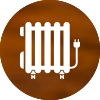We in America love our dams. They are symbols of American ingenuity. The water churning through the energy-producing turbines of the massive Hoover Dam is a symbol of what the country can accomplish when it puts its mind to a task. There are some 80,000 dams in the United States, and each provides hydropower to a nearby community.
Or so you’d think.
Untapped Potential
 As a matter of fact, very few dams are used to harness the energy-saving potential of water. Not even three percent of the nation’s dams produce power. Why? Dams, as we currently imagine them, are actually quite bulky, inefficient power-saving structures. So why are we talking about the potential of American hydropower if dams are an outdated clean energy source?
As a matter of fact, very few dams are used to harness the energy-saving potential of water. Not even three percent of the nation’s dams produce power. Why? Dams, as we currently imagine them, are actually quite bulky, inefficient power-saving structures. So why are we talking about the potential of American hydropower if dams are an outdated clean energy source?
I’m glad I asked.
“Reviving hydropower does not mean recreating the hulking masses of concrete that defined mid-20th-century power development,” Brett Walton of Circle of Blue writes. “The prime spots are already plugged, and big new dams no longer fit the time . . . The alternative model is to make better use of infrastructure already in the ground.”
The 21st-Century Dam
 Let’s find out what that alternative model looks like. If we lack imagination, it could be costly. As Walton writes, many 20th century dams are problematic: they clog our waterways, disrupting delicate ecosystems and sterilize our watersheds. But if we make minor repairs and additions to existing infrastructure, we could easily utilize the power of our nation’s rivers.
Let’s find out what that alternative model looks like. If we lack imagination, it could be costly. As Walton writes, many 20th century dams are problematic: they clog our waterways, disrupting delicate ecosystems and sterilize our watersheds. But if we make minor repairs and additions to existing infrastructure, we could easily utilize the power of our nation’s rivers.
For example, adding a power turbine to an existing dam, although not perfectly ecologically sound, is much less destructive to the environment than erecting an entirely new dam. Structures called “pump storage” dams, which use excess energy to pump water from a low-elevation reservoir to a high-elevation one, are already clean energy success stories in European countries. And tearing down old, non-energy supplying dams could revitalize neglected ecosystems and chart a course for the new century’s dam decision-making process.
We haven’t figured out hydropower. But if we take a good hard look at the problem and choose our dam sites wisely, there’s no reason dams shouldn’t be a part of this century’s clean energy revolution.


 By far, the most popular way to heat a home is with a furnace or boiler. Furnaces heat air and distribute it through the house using ducts. Boilers heat water, which is delivered through baseboard radiators or a radiant floor system, or heat air through a coil.
By far, the most popular way to heat a home is with a furnace or boiler. Furnaces heat air and distribute it through the house using ducts. Boilers heat water, which is delivered through baseboard radiators or a radiant floor system, or heat air through a coil. Heat pumps—Heat pumps move heat instead of generating it. They use electricity to move heat from a cool space to a warm space, so the cool space is cooler and the warm space is warmer. In the winter, heat pumps move heat from the cool outdoors into your warm house. Conversely, in the summer, heat pumps move heat from your cool house into the warm outdoors.
Heat pumps—Heat pumps move heat instead of generating it. They use electricity to move heat from a cool space to a warm space, so the cool space is cooler and the warm space is warmer. In the winter, heat pumps move heat from the cool outdoors into your warm house. Conversely, in the summer, heat pumps move heat from your cool house into the warm outdoors. Solar Energy—As its name implies, active solar heating uses the natural energy from the sun to heat either liquid or gas, and then transfers this solar heat to a storage system for later use.
Solar Energy—As its name implies, active solar heating uses the natural energy from the sun to heat either liquid or gas, and then transfers this solar heat to a storage system for later use. Electric Resistance Heating—This system is 100 percent energy-efficient because it converts all the incoming electric energy into heat. But it is also among the costliest, because most of the electricity is generated from coal, gas, or oil, which has a fuel-to-electricity conversion rate of only about 30 percent.
Electric Resistance Heating—This system is 100 percent energy-efficient because it converts all the incoming electric energy into heat. But it is also among the costliest, because most of the electricity is generated from coal, gas, or oil, which has a fuel-to-electricity conversion rate of only about 30 percent. Wood and Pellet Heating—Today’s generation of wood- and pellet-burning appliances are more efficient and powerful enough to heat most average-sized homes. They also burn cleaner.
Wood and Pellet Heating—Today’s generation of wood- and pellet-burning appliances are more efficient and powerful enough to heat most average-sized homes. They also burn cleaner. Steam and Hot Water Radiators—Steam radiators are one of the oldest heating systems around. However, the process of boiling and condensing liquid into heat is not as efficient as more modern-day systems. Hot water radiators are very popular in newer homes. The most common types are baseboard or upright style.
Steam and Hot Water Radiators—Steam radiators are one of the oldest heating systems around. However, the process of boiling and condensing liquid into heat is not as efficient as more modern-day systems. Hot water radiators are very popular in newer homes. The most common types are baseboard or upright style. Radiant Heating—Radiant heating systems deliver heat directly from a hot surface to people and objects in the room through infrared radiation. If you have ever felt heat from across the room from a stove top, you’ve experienced radiant heating.
Radiant Heating—Radiant heating systems deliver heat directly from a hot surface to people and objects in the room through infrared radiation. If you have ever felt heat from across the room from a stove top, you’ve experienced radiant heating. Portable Heaters—When you need to supplement an inadequate heating system or central heat is cost prohibitive, portable heaters are a good alternative, especially if you only need to heat one room. Take safety considerations when purchasing one by making sure it:
Portable Heaters—When you need to supplement an inadequate heating system or central heat is cost prohibitive, portable heaters are a good alternative, especially if you only need to heat one room. Take safety considerations when purchasing one by making sure it: Apple wanted to solve the problem of waste that comes with throwing away old electronics or replacing them with news ones. The company’s solution:
Apple wanted to solve the problem of waste that comes with throwing away old electronics or replacing them with news ones. The company’s solution:  While this is quite a heavy goal, Apple is determined to use energy that is
While this is quite a heavy goal, Apple is determined to use energy that is  Apple has vowed to protect and preserve the forest as much as possible. That being said, they have begun to use recycled products for their packaging. Not only are they recycling paper products, they have also vowed to reduce their water usage as well. In order to diminish the amounts of their products in landfills, Apple implemented the
Apple has vowed to protect and preserve the forest as much as possible. That being said, they have begun to use recycled products for their packaging. Not only are they recycling paper products, they have also vowed to reduce their water usage as well. In order to diminish the amounts of their products in landfills, Apple implemented the  A lot of electronic products contain
A lot of electronic products contain  Metro of Santiago, an underground railway network, serves Chile’s capital city. The system was once described by
Metro of Santiago, an underground railway network, serves Chile’s capital city. The system was once described by  The Metro will receive power generated from the El Pelicano Solar project, a 100-megawatt solar power plant going up near the cities of La Higuera and Vallenar. An agreement between Total and SunPower Corp. says the latter will purchase 300 gigawatt hours per year for “the supply of clean, solar energy” to Metro of Santiago. Oil and gas company, Total, is the world’s second ranked solar energy operator with SunPower.
The Metro will receive power generated from the El Pelicano Solar project, a 100-megawatt solar power plant going up near the cities of La Higuera and Vallenar. An agreement between Total and SunPower Corp. says the latter will purchase 300 gigawatt hours per year for “the supply of clean, solar energy” to Metro of Santiago. Oil and gas company, Total, is the world’s second ranked solar energy operator with SunPower. Eduardo Medina is SunPower’s executive vice president of global power plants. He says, “Solar is an ideal energy source for Chile because of the country’s high solar resource and transparent energy policies.”
Eduardo Medina is SunPower’s executive vice president of global power plants. He says, “Solar is an ideal energy source for Chile because of the country’s high solar resource and transparent energy policies.”